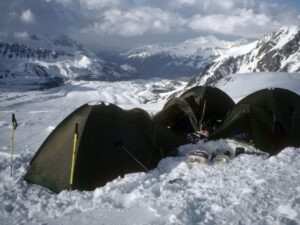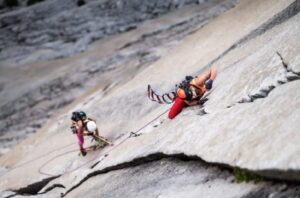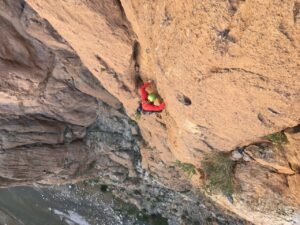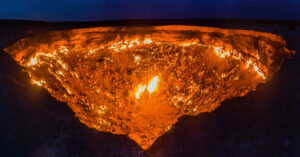Last week, after 68 days and 1,400km across the Atlas Mountains from Nador to Ourzazate, Alice Morrison finished the third leg of her Moroccan trilogy. In 2019, she trekked the 1,200km length of the Draa River, and this February, she covered 2,000km across the Sahara.
As on her Sahara venture, six camels carried her gear, and three local guides (Brahim, Addi and Ali) dealt with officials along the way. Her friend and fellow explorer, Jean-Pierre Datcharry, took on the role of organizer and also built their traditional nomadic tents.
She is now finishing a book about the expedition and waiting to find out if she will be able to spend Christmas in her native Scotland, after a second UK lockdown was announced.

The team approaches Lake Tisli. Photo: Alice Morrison
Since COVID is still here, did you feel more pressure to finish quickly in case there was another lockdown?
No, but COVID was with us throughout the walk. First, it was very hard to get permission to go, since the last thing the authorities want is this European woman wandering around their country when they have more serious things to worry about. But Jean-Pierre did the most incredible work, sitting for hours in government offices until it was all sorted.
The other time COVID was very apparent was when you were meeting people. We always took our cue from them. We would wear our masks and only take them off if the whole community wasn’t wearing a mask. We were so isolated and we’d all been tested, so we knew we didn’t have it. And they didn’t have it because they’re in such isolated communities. Some communities we met in the middle Atlas Mountains were a bit nervous toward us, so we just stayed away.
The first question we asked every community was, do you have any cases in your area? In 68 days, there was not one.
You were in quite a strict lockdown before you went on this expedition. How did you train for this?
I finished the Sahara section in February, feeling very happy with myself. And I was thinking, I’ve got a great base fitness; I can walk up a mountain really quickly. I’m feeling really good. I’ve lost weight. Then the 13 weeks of lockdown happened. For the first four weeks, I did my home workouts, but by the end I was like just sitting and mainlining shortbread cookies. I did manage to get in some training in the mountains before we started, but not loads.

Crossing the River Za. Photo: Alice Morrison
Did that affect your expedition?
I thought it was going to be a nightmare because we were in the mountains from day one. I had all my lovely new kit and it was a bit tight right in the middle, to say the least. But because of the camels, we had to walk very slowly in the beginning anyway. Instead of doing 25km per day in five hours, like we did in the Sahara, we did 18-20km. That’s a big difference. The camels were in terrible condition because of a drought and shortage of food. Tourists usually fund food for working camels, but COVID stopped that.
So we had to conserve their energy. By the end of the expedition, they were back to being fat and in good condition.
You mentioned previously that the camels really struggled with the heat during this expedition.
Yes! We started off in August, the nightmare time for any expedition in Africa. It was still 48˚C at eight o’clock in the evening. Also, these are desert camels, so when we started going uphill in such heat, they really suffered. On the first day, one just sat down and folded his legs: No amount of coaxing would get him up. So we took off his luggage and left him there for a little while, then Brahim went back to collect him after it had cooled down. We actually swapped two camels out because they had foot problems and brought two new ones up by truck about halfway through the expedition.
There was lots of camel excitement on this trip. They got leeches under their tongues from drinking from natural pools. One day I was looking at Hamish, my favorite camel, and he had blood all around his mouth.
Hamish is an alpha male and he bites, so it’s quite a tricky business. It took all three of them to get the leeches out. They had to neutralize his teeth, so they put a metal tent pole in the back of his mouth because he bit through the wooden pole. He’s completely tied up because otherwise his legs would kick the heck out of everybody. So one man is holding his head, one is holding his mouth open, and the other man was trying to push the leech off his tongue with a stick but he can’t get it. So in the end, Adi’s plunging his hand into Hamish’s mouth, Hamish is freaking out, thrashing around, and froth and blood are going everywhere. Eventually, Adi pulled the leech out with his hand. It was about the length of my forefinger. It was so gross.
When we spoke last time, you said that the Sahara was really monotonous. Was this different?
The mountains of Morocco are absolutely beautiful. There is no other word for it. You have these high craggy mountains or wide-open plains with mountains on each side. We saw eagles soaring over the plains. We walked through Midelt, an apple-growing region, in the harvest season. So suddenly you come out of a Lord of the Rings-type barren mountain and you go down into a plain and it’s bright green. Everything is green. There is maize growing, and tomatoes, and apples and figs falling off the trees. Where there is water, it’s like the Garden of Eden. We all gorged on apples, which is funny because when I first came to Morocco, I used to bring apples from Scotland because I couldn’t find really firm, crisp apples.
You had to tackle many types of terrain. Did that make it harder?
Actually, it was easier because when I am just on the flats, I get really sore hips because you’re doing the gait for days. Going up and down uses slightly different muscles. So actually, the ups and downs felt easier for me, which is counterintuitive.
Psychologically, it was much more pleasurable as well. There were plants, flowers and people. There are all sorts of things to enjoy, even just different shapes: You have pointy mountains, rugged mountains, you have valleys with some incredible gorges, and the plains. This part of the journey was like a reward because it was so full of life and different types of scenery. We started in boiling heat and we finished in snow.

Camp at Sidi Hamza. Photo: Alice Morrison
What was the response of the communities you went through?
They were incredibly supportive. On social media, you currently see a lot of debate about whether a white person should be walking through Africa. The comments are mostly negative. All I would say is, spend one day walking with me and see the response you get from the actual people who live here. They love the camels, and the village kids run ahead of us doing cartwheels. Then they want to run under the tummy of the camel because it’s traditionally good luck. Mothers would give us their babies to pass under the belly of the camel.
We’d sit and have tea and they would say, “Thank you so much for coming and telling other people about our country. Thank you for learning Arabic. It’s so nice to see a foreigner.” And a lot of people said it’s was fantastic to see something positive in COVID times. People were literally chasing us to give us things.
A lot of the ways of life we experienced seemed to me almost medieval: The woman walking up the mountains to collect brushwood for winter and then rolling it down the slope, for example. I was saying this all to Brahim, and he just started laughing and said, “You do realize that this is what they’re saying about us? ‘Oh, look at them with the camels, it’s like something from our ancestors.’”
Did the religion of the country make it more difficult for you on your journey or as a woman?
On the contrary, I found it incredibly enriching to learn more about Islam and to be with three men who are true Muslims. Along the way, Brahim taught me parts of the Koran, lots and lots of different verses. I speak Arabic, and it is the most beautiful language. It’s like learning poetry, but with a spiritual meaning. And I’ve really benefited from spending time with people who really believe.
Before I started, I thought that I would find it difficult. I thought that would be a barrier between us because I’m not Muslim and I’m a woman. That wasn’t the case at all. I was welcomed and treated like family. Many of my own assumptions and stereotypes were shattered.

Brahim, Addi and Ali waiting for the sun to set so that they can start evening prayers. Photo: Alice Morrison
What was the best part of the Atlas Mountain trek?
I found dinosaur tracks. If you want one single high point, it’s definitely putting my hand in a dinosaur footprint.
Can you tell us a bit more about that?
Morocco was a haven for dinosaurs because of its topography and the way the Atlas Mountains were created. The oldest dinosaur in the world has allegedly been found here. I was in touch with Dr. Susannah Maidment from the Natural History Museum in the UK, which does a lot of work here, and she told me to have a look.
For nine weeks, we were looking for dinosaur footprints, and the guys were just laughing at me. They’d hold up chicken bones and say, “Look it’s a dinosaur toe.” In the last 10 days, we made it to a village called Aguerzka. Unknown to us, my organizer, Jean-Pierre, had been scouring the Internet and found a map of where three previous sets of prints have been found. So he came in advance and tracked down these footprints and set up some climbing gear. We climbed up and had a really good scout around these footprints. Once you’ve seen them, you know what you’re looking for. They’re big and they’re in a certain line and they’re on certain types of rocks. So after that, we were on fire.

Dinosaur prints in Aguerzka. Photo: Alice Morrison
We carried on, but I was determined to return and find new footprints. When we went back, suddenly Brahim said, “Look, I think there are footprints up there.” We bloody well found a new site! So we go clambering up and quickly marked the GPS points, took loads of photos, and I send them off to Dr Maidment. She agreed that they are consistent with dinosaur footprints, but that she’d have to be there to confirm, which is fair enough.

Dinosaur prints in Aguerzka. Photo: Alice Morrison
What did you find most difficult about this trek?
You have to accept that something like this is difficult. You’re never physically comfortable. You’re constantly in a state of alertness, not just me, but the team as well. You get physically and mentally tired, walking day after day. Also, I’m working in completely different languages than my own.
How did this section compare to the other two parts of your trilogy?
I honestly can’t compare them because they’ve been so different, but I’m really glad I kept going after the Draa River. The Draa was a perfect trip, perfect length, and I discovered so many exciting things. It was a perfect jewel of an expedition and part of me thought, I don’t want to continue and spoil that. But I’m so glad I continued. The next section through the Sahara was extremely difficult, then this last stage was just full of richness and beauty.
You can find out more about Alice’s Moroccan Trilogy here.






